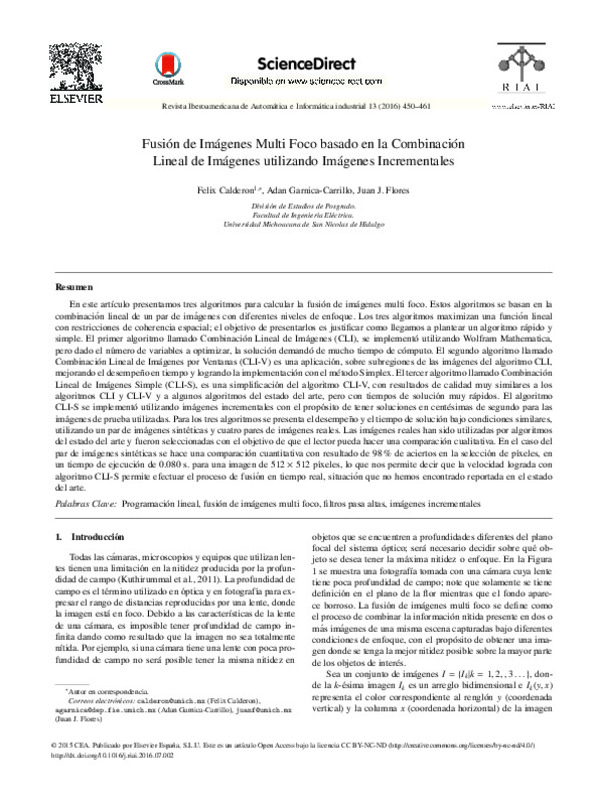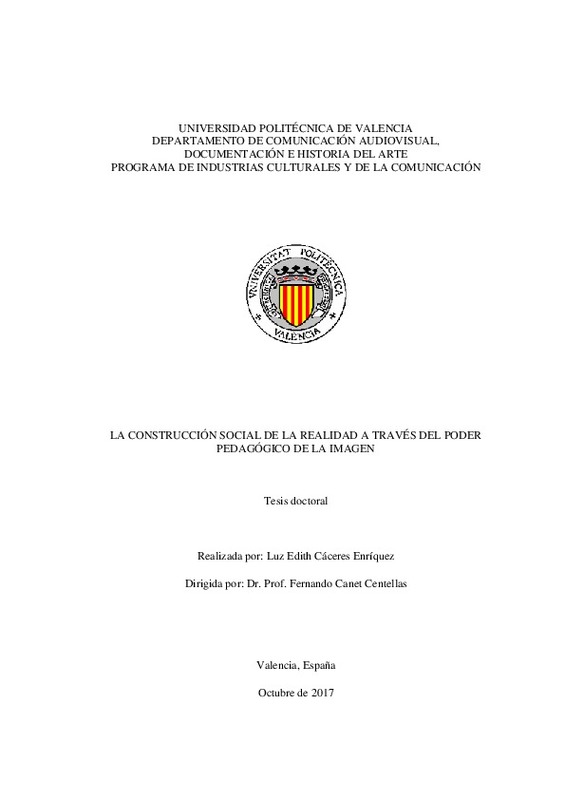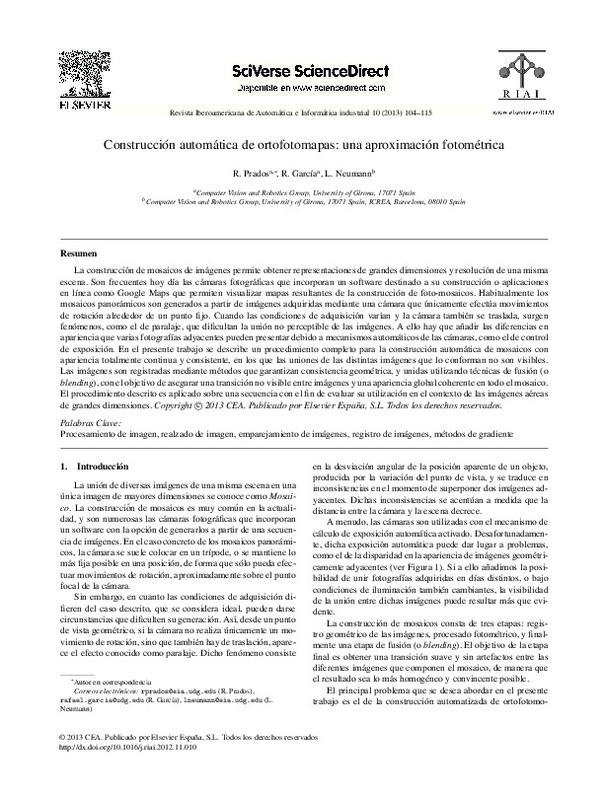JavaScript is disabled for your browser. Some features of this site may not work without it.
Buscar en RiuNet
Listar
Mi cuenta
Estadísticas
Ayuda RiuNet
Admin. UPV
Fusión de Imágenes Multi Foco basado en la Combinación Lineal de Imágenes utilizando Imágenes Incrementales
Mostrar el registro sencillo del ítem
Ficheros en el ítem
| dc.contributor.author | Calderón, Félix
|
es_ES |
| dc.contributor.author | Garnica Carrillo, Adán
|
es_ES |
| dc.contributor.author | Flores, Juan J.
|
es_ES |
| dc.date.accessioned | 2020-05-18T10:45:03Z | |
| dc.date.available | 2020-05-18T10:45:03Z | |
| dc.date.issued | 2016-10-10 | |
| dc.identifier.issn | 1697-7912 | |
| dc.identifier.uri | http://hdl.handle.net/10251/143541 | |
| dc.description.abstract | [ES] En este artículo presentamos tres algoritmos para calcular la fusión de imágenes multi foco. Estos algoritmos se basan en la combinación lineal de un par de imágenes con diferentes niveles de enfoque. Los tres algoritmos maximizan una función lineal con restricciones de coherencia espacial; el objetivo de presentarlos es justificar como llegamos a plantear un algoritmo rápido y simple. El primer algoritmo llamado Combinación Lineal de Imágenes (CLI), se implementó utilizando Wolfram Mathematica, pero dado el número de variables a optimizar, la solución demandó de mucho tiempo de cómputo. El segundo algoritmo llamado Combinación Lineal de Imágenes por Ventanas (CLI-V) es una aplicación, sobre subregiones de las imágenes del algoritmo CLI, mejorando el desempeñxo en tiempo y logrando la implementación con el método Simplex. El tercer algoritmo llamado Combinación Lineal de Imágenes Simple (CLI-S), es una simplificación del algoritmo CLI-V, con resultados de calidad muy similares a los algoritmos CLI y CLI-V y a algunos algoritmos del estado del arte, pero con tiempos de solución muy rápidos. El algoritmo CLI-S se implementó utilizando imágenes incrementales con el propósito de tener soluciones en centésimas de segundo para las imágenes de prueba utilizadas. Para los tres algoritmos se presenta el desempeño y el tiempo de solución bajo condiciones similares, utilizando un par de imágenes sintéticas y cuatro pares de imágenes reales. Las imágenes reales han sido utilizadas por algoritmos del estado del arte y fueron seleccionadas con el objetivo de que el lector pueda hacer una comparación cualitativa. En el caso del par de imágenes sintéticas se hace una comparación cuantitativa con resultado de 98% de aciertos en la selección de píxeles, en un tiempo de ejecución de 0.080 s. para una imagen de 512 × 512 píxeles, lo que nos permite decir que la velocidad lograda con algoritmo CLI-S permite efectuar el proceso de fusión en tiempo real, situación que no hemos encontrado reportada en el estado del arte. | es_ES |
| dc.description.abstract | [EN] This article presents three algorithms to determinate multifocus image fusion. These algorithms are based on a linear combination of two images with different focus distances. The three algorithms maximize a linear function with spatial coherence constrains. We present these algorithms in sequence to show how we devised a fast and simple algorithm. The first algorithm, CLI (for its acronym in spanish Combinación Lineal de Imágenes) was implemented using Wolfram Mathematica, but given the number of variables to optimize, the solution takes a lot of computing time. The second algorithm, CLI-V (for its acronym in spanish Combinación Lineal de Imágenes por Ventanas) is an application of algorithm CLI on image regions to improve the time performance and being able to implement it through the Simplex method. The third algorithm, CLI-S (for its acronym in spanish Combinación Lineal de Imágenes Simple), is a simplification on CLI-V. This last algorithm is much faster exhibiting results of similar quality to the previous two, with a performance comparable to the results presented in the state of the art. CLI-S was implemented using the concept of integral images. This fact allows the algorithm to produce results in hundredth of a second for the test images analized. The results of the three algorithms are compared using one set of synthetic and four sets of real images. The real images are commonly used by the state of the art proposal; they were so that the reader can make a qualitative comparison of results. The synthetic images are reconstructed with 98% accuracy in 0.080 s. and the image size is 512 × 512, this situation allows us to say that CLI-S can be used as a real-time algorithm of multifocus image fusion and we have not found a similar proposal in the state of art. | es_ES |
| dc.language | Español | es_ES |
| dc.publisher | Universitat Politècnica de València | es_ES |
| dc.relation.ispartof | Revista Iberoamericana de Automática e Informática industrial | es_ES |
| dc.rights | Reconocimiento - No comercial - Sin obra derivada (by-nc-nd) | es_ES |
| dc.subject | Linear Programming | es_ES |
| dc.subject | Muitifocus images fusion | es_ES |
| dc.subject | High pass filters | es_ES |
| dc.subject | Integral images | es_ES |
| dc.subject | Programación lineal | es_ES |
| dc.subject | Fusión de imágenes multi foco | es_ES |
| dc.subject | Filtros pasa altas | es_ES |
| dc.subject | Imágenes incrementales | es_ES |
| dc.title | Fusión de Imágenes Multi Foco basado en la Combinación Lineal de Imágenes utilizando Imágenes Incrementales | es_ES |
| dc.title.alternative | Multi Focus Image Fusion based on Linear Combination of Images using Incremental Images | es_ES |
| dc.type | Artículo | es_ES |
| dc.identifier.doi | 10.1016/j.riai.2016.07.002 | |
| dc.rights.accessRights | Abierto | es_ES |
| dc.description.bibliographicCitation | Calderón, F.; Garnica Carrillo, A.; Flores, JJ. (2016). Fusión de Imágenes Multi Foco basado en la Combinación Lineal de Imágenes utilizando Imágenes Incrementales. Revista Iberoamericana de Automática e Informática industrial. 13(4):450-461. https://doi.org/10.1016/j.riai.2016.07.002 | es_ES |
| dc.description.accrualMethod | OJS | es_ES |
| dc.relation.publisherversion | https://doi.org/10.1016/j.riai.2016.07.002 | es_ES |
| dc.description.upvformatpinicio | 450 | es_ES |
| dc.description.upvformatpfin | 461 | es_ES |
| dc.type.version | info:eu-repo/semantics/publishedVersion | es_ES |
| dc.description.volume | 13 | es_ES |
| dc.description.issue | 4 | es_ES |
| dc.identifier.eissn | 1697-7920 | |
| dc.relation.pasarela | OJS\9262 | es_ES |
| dc.description.references | Alonso, J. R., Fernandez, A., Ayubi, G. A., Ferrari, J. A., Apr 2015. All-in-focus ' image reconstruction under severe defocus. Opt. Lett. 40 (8), 1671-1674. | es_ES |
| dc.description.references | Bae, S., Durand, F., 2007. Defocus magnification. Computer Graphics Forum 26 (3), 571-579. | es_ES |
| dc.description.references | Burt, P., Adelson, E., Apr 1983. The laplacian pyramid as a compact image code. Communications, IEEE Transactions on 31 (4), 532-540. | es_ES |
| dc.description.references | Burt, P., Kolczynski, R., May 1993. Enhanced image capture through fusion. In: Computer Vision, 1993. Proceedings., Fourth International Conference on. pp. 173-182. | es_ES |
| dc.description.references | Cao, L., Jin, L., Tao, H., Li, G., Zhuang, Z., Zhang, Y., Feb 2015. Multi-focus image fusion based on spatial frequency in discrete cosine transform domain. Signal Processing Letters, IEEE 22 (2), 220-224. | es_ES |
| dc.description.references | Chai, Y., Li, H., Guo, M., 2011. Multifocus image fusion scheme based on features of multiscale products and {PCNN} in lifting stationary wavelet domain. Optics Communications 284 (5), 1146 - 1158. | es_ES |
| dc.description.references | Elder, J., Zucker, S., Jul 1998. Local scale control for edge detection and blur estimation. Pattern Analysis and Machine Intelligence, IEEE Transactions on 20 (7), 699-716. | es_ES |
| dc.description.references | Gonzalez, R. C., Woods, R. E., 2008. Digital image processing. Prentice Hall, Upper Saddle River, N.J. | es_ES |
| dc.description.references | Kuthirummal, S., Nagahara, H., Zhou, C., Nayar, S., Jan 2011. Flexible depth of field photography. Pattern Analysis and Machine Intelligence, IEEE Transactions on 33 (1), 58-71. | es_ES |
| dc.description.references | Li, S., Kwok, J. T., Wang, Y., 2001. Combination of images with diverse focuses using the spatial frequency. Information Fusion 2 (3), 169 - 176. | es_ES |
| dc.description.references | Li, S., Kwok, J. T., Wang, Y., 2002. Multifocus image fusion using artificial neural networks. Pattern Recognition Letters 23 (8), 985 - 997. | es_ES |
| dc.description.references | Li, S., Yang, B., 2008. Multifocus image fusion using region segmentation and spatial frequency. Image and Vision Computing 26 (7), 971 - 979. | es_ES |
| dc.description.references | Luenberger, D., 1973. Introduction to Linear and Nonlinear Programming. Addison-Wesley Publishing Company. | es_ES |
| dc.description.references | Orozco, R. I., 2013. Fusion de im ' agenes multifoco por medio de filtrado de ' regiones de alta y baja frecuencia. Master's thesis, Division de Estudios de ' Postgrado. Facultad de Ingenier'ıa Electrica. UMSNH, Morelia Michoacan ' Mexico. | es_ES |
| dc.description.references | Pagidimarry, M., Babu, K. A., 2011. An all approach for multi-focus image fusion using neural network. Artificial Intelligent Systems and Machine Learning 3 (12), 732-739. | es_ES |
| dc.description.references | Pajares, G., de la Cruz, J. M., 2004. A wavelet-based image fusion tutorial. Pattern Recognition 37 (9), 1855 - 1872. | es_ES |
| dc.description.references | Redondo, R., Sroubek, F., Fischer, S., Crist ˇ obal, G., 2009. Multifocus image ' fusion using the log-gabor transform and a multisize windows technique. Information Fusion 10 (2), 163 - 171. | es_ES |
| dc.description.references | Riaz, M., Park, S., Ahmad, M., Rasheed, W., Park, J., 2008. Generalized laplacian as focus measure. In: Bubak, M., van Albada, G., Dongarra, J., Sloot, P. (Eds.), Computational Science ? ICCS 2008. Vol. 5101 of Lecture Notes in Computer Science. Springer Berlin Heidelberg, pp. 1013-1021. | es_ES |
| dc.description.references | Rivera, M., Ocegueda, O., Marroquin, J., Dec 2007. Entropy-controlled quadratic markov measure field models for efficient image segmentation. Image Processing, IEEE Transactions on 16 (12), 3047-3057. | es_ES |
| dc.description.references | Terlaky, T., 2013. Interior point methods of mathematical programming. Vol. 5. Springer Science & Business Media. | es_ES |
| dc.description.references | Viola, P., Jones, M., 2001. Rapid object detection using a boosted cascade of simple features. In: Computer Vision and Pattern Recognition, 2001. CVPR 2001. Proceedings of the 2001 IEEE Computer Society Conference on. Vol. 1. pp. I-511-I-518 vol.1. | es_ES |
| dc.description.references | Wiener, N., 1964. Extrapolation, interpolation, and smoothing of stationary time series : with engineering applications. M.I. T. paperback series. Cambridge, Mass. Technology Press of the Massachusetts Institute of Technology, first published during the war as a classified report to Section D2, National Defense Research Committee. | es_ES |
| dc.description.references | Zhang, Q., long Guo, B., 2009. Multifocus image fusion using the nonsubsampled contourlet transform. Signal Processing 89 (7), 1334 - 1346. | es_ES |











